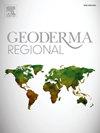Better management zoning with elevation than with three soil classifications in a periodically waterlogged plot
IF 3.3
2区 农林科学
Q2 SOIL SCIENCE
引用次数: 0
Abstract
Following a comparison of the practical applicability of USDA Soil Taxonomy (ST), Hungarian soil classification (HU), and WRB in a slightly saline alluvial plot (Tóth et al., 2021), in this study, we compared the polygon alignment derived from the three systems, relative to the pattern of elevation and mean NDVI. The final objective focused on delineating potential management zones. The study plot is the largest salt-affected plot in the country (0.9 km2). Within this plot, 85 undisturbed, 1 m deep profiles were collected, sampled, described and classified using a 100 × 100 m grid. We described the polygon alignment qualitatively and through the use of landscape metrics. Additionally, we evaluated number of classes and polygons, and delineated potential management zones based on environmental variables.
Large dominant polygons were found at level 1, the least detailed of all three classifications. The polygons became increasingly fragmented at levels 2, 3 and 4, where isolated single raster cell polygons dominated the plot in each classification: 96 % in WRB, 73 % in HU and 70 % in ST, compared to the total number of polygons. Landscape metrics proved that ST exhibited the best north–south orientation (the orientation of highs/lows), length, perimeter, area, aggregation and interspersion/juxtaposition of polygons. HU showed an intermediate performance, while WRB had the least satisfactory alignment with the north–south orientation, length, perimeter and area, as well as patch cohesion and aggregation of polygons. After analyzing the scatterplot of elevation versus mean NDVI, and also elevation versus long-term NDVI range, we noted a cutpoint of 95.47 m, which separated the more productive and less variable zone from the lower lying less productive less certain zone, given its periodical precipitation-related waterlogging.
在周期性涝渍地,采用高程分区比采用三种土壤分类更好
在比较了美国农业部土壤分类(ST)、匈牙利土壤分类(HU)和WRB在一个微含盐冲积区(Tóth et al., 2021)的实际适用性之后,本研究比较了三种系统得出的多边形排列,相对于高程和平均NDVI的格局。最后的目标是划定潜在的管理区。该研究地块是该国最大的盐害地块(0.9平方公里)。在这个地块内,使用100 × 100米的网格收集、采样、描述和分类了85个未受干扰的1米深剖面。我们定性地描述了多边形对齐,并通过使用景观度量。此外,我们评估了类别和多边形的数量,并根据环境变量划定了潜在的管理区域。大的优势多边形在第一级被发现,这是所有三个分类中最不详细的。在第2、3和4级,多边形变得越来越破碎,在每个分类中,孤立的单栅格细胞多边形占主导地位:与多边形总数相比,WRB占96%,HU占73%,ST占70%。景观指标表明,ST表现出最佳的南北朝向(高/低方向)、长度、周长、面积、多边形聚集和穿插/并置。HU表现中等,而WRB在多边形的南北取向、长度、周长和面积、斑块内聚性和聚集性方面表现最差。通过分析高程与平均NDVI的散点图,以及高程与长期NDVI范围的散点图,我们注意到一个95.47 m的切点,该切点将高产且变化较少的区域与低高产且不确定的区域分开,因为其周期性与降水相关的内涝。
本文章由计算机程序翻译,如有差异,请以英文原文为准。
求助全文
约1分钟内获得全文
求助全文
来源期刊

Geoderma Regional
Agricultural and Biological Sciences-Soil Science
CiteScore
6.10
自引率
7.30%
发文量
122
审稿时长
76 days
期刊介绍:
Global issues require studies and solutions on national and regional levels. Geoderma Regional focuses on studies that increase understanding and advance our scientific knowledge of soils in all regions of the world. The journal embraces every aspect of soil science and welcomes reviews of regional progress.
 求助内容:
求助内容: 应助结果提醒方式:
应助结果提醒方式:


